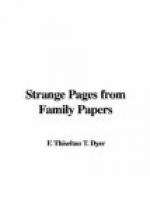“They may be fables,” she replied, “but is this a fable?” And she produced the hand and ring, upon which the constables appeared on the scene, and took Baker into custody. The tradition adds that he was found guilty, and was burnt, notwithstanding that Queen Mary tried to save him on account of his holding the Roman Catholic religion.[24]
This tradition, of course, must not be taken too seriously; the red hand in the armorial bearings having led, it has been suggested, to the supposition of some sanguinary business in the records of the family. Among the monuments in Cranbrook Church, Kent, there is one erected to Sir Richard Baker—the gauntlet, red gloves, helmet, and spurs, having been suspended over the tomb. On one occasion, a visitor being attracted by the colour of the gloves, was accosted by an old woman, who remarked, “Aye, Miss, those are Bloody Baker’s gloves; their red colour comes from the blood he shed.” But the red hand is only the Ulster badge of baronetcy, and there is scarcely a family bearing it of which some tale of murder and punishment has not been told.
FOOTNOTES:
[19] Andrew’s “History of Great Britain,” 1794-5.
[20] Oxford, 1857.
[21] “Scenes and Legends of the Vale of Strathmore.” J. Cargill Guthrie, 1875.
[22] “All the Year Round,” 1880.
[23] See “Wilts Archaeological Magazine,” vols. i.-x.
[24] See “Notes and Queries,” 1st S., I., p. 67.
CHAPTER VI.
Indelible blood stains.
“Will all great Neptune’s
ocean wash this blood
Clean from my hand? No;
this my hand will rather
The multitudinous seas incarnardine,
Making the green one red.”—Macbeth.
It was a popular suggestion in olden times that when a person had died a violent death, the blood stains could not be washed away, to which Macbeth alludes, as above, after murdering Duncan. This belief was in a great measure founded on the early tradition that the wounds of a murdered man were supposed to bleed afresh at the approach or touch of the murderer. To such an extent was this notion carried, that “by the side of the bier, if the slightest change were observable in the eyes, the mouth, feet, or hands of the corpse, the murderer was conjectured to be present, and many an innocent spectator must have suffered death. This practice forms a rich pasture in the imagination of our old writers; and their histories and ballads are laboured into pathos by dwelling on this phenomenon."[25] At Blackwell, near Darlington, the murder of one Christopher Simpson is described in a pretty local ballad known as “The Baydayle Banks Tragedy.” A suspected person was committed, because when he touched the body at the inquest, “upon his handlinge and movinge, the body did bleed at the mouth, nose, and ears,” and he turned out to be the murderer. Similarly Macbeth (Act iii., sc. 4), speaking of the ghost, says:—




